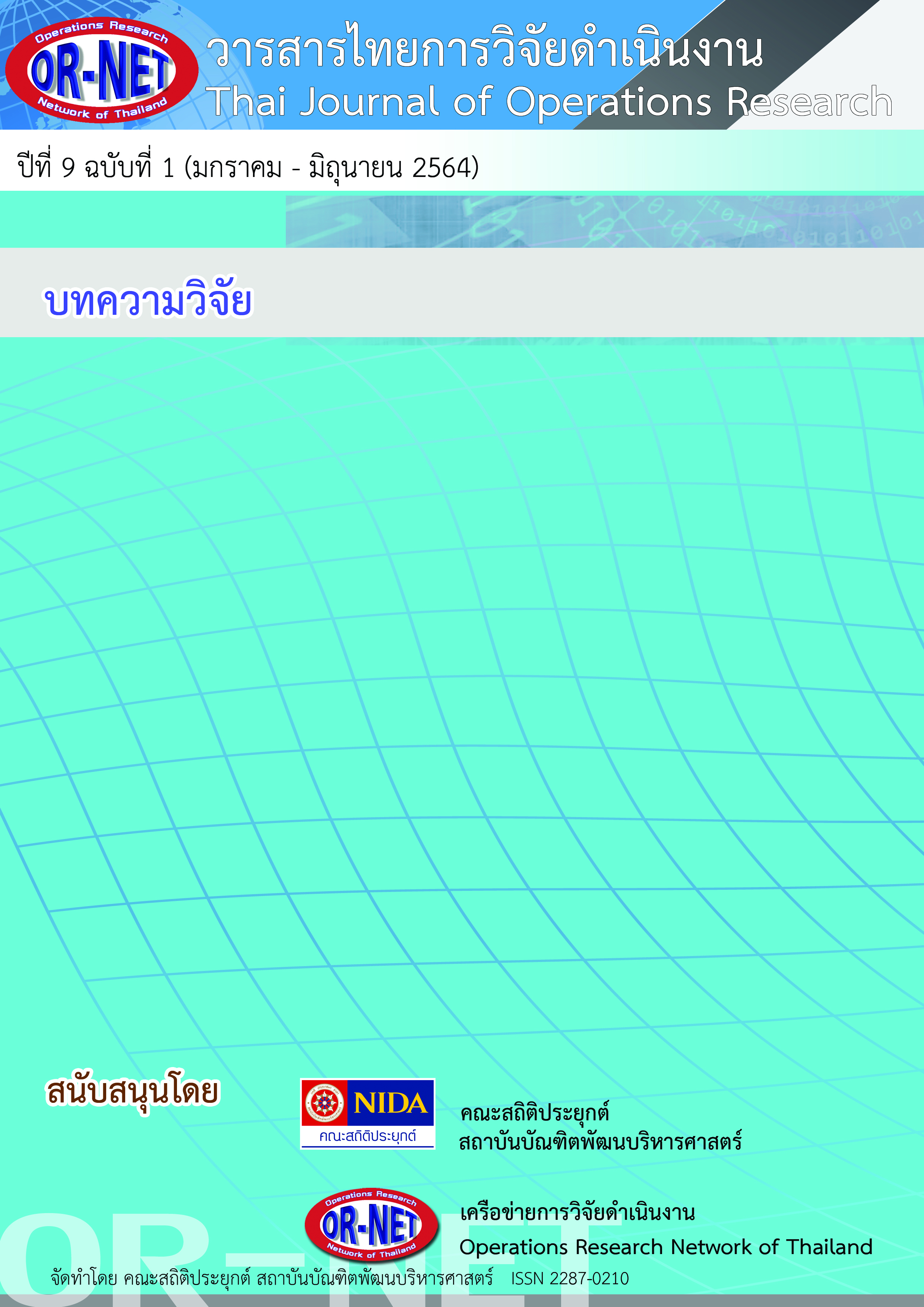Applying a two-stage clustering-assignment model for an item-associated product family warehouse storage location problem
Keywords:
Storage location reassignment problem, Item-based associations technique, Assignment problem, Case studyAbstract
The objective of this research was to re-design the storage location of raw materials and common products in the warehouse of a chain restaurant as the case study. An existing problem is unproductive travelling distance and non-value-added time-consuming order picking by the customer orders because of an inappropriate layout. As observed, the nature of the picking processes indicate that pickers pick the individual items by each brand along with common products that share together for all brands. To design new appropriate locations and product zones for each SKUs, this study proposed a Two-Stages Clustering-Assignment Model to deal with classifying product groups and determining product placements problems. Firstly, was to find Item-based associations of both product groups (items and all brands). Secondly, was then to determine placements for associated items by formulating the problem as warehouse storage location assignment problem so as to minimize picking distance. OpenSolver2.9.3_Beta_LinearWin was used to find the optimal solution. The result shows that the new configuration help reducing picking distance by 56% comparing to the current storage locations. This benefit proves more efficient as it reduces pickers from 11 to 8 regular staffs, which in turns saving labor costs about 39,000 baht per month or 468,000 baht per year.
References
[2] อนิรุต ทรัพย์สุคนธ์, 2559. การวางผังคลังสินค้าห้องเย็นกรณีศึกษา ห้องเย็นส.ทรัพย์สมุทร. วิทยานิพนธ์ปริญญามหาบัณฑิต มหาวิทยายาลัยศรีปทุม.
[3] Bartholdi, J. J., & Hackman, S. T. (2008). Warehouse & Distribution Science: Release 0.89. Atlanta: Supply Chain and Logistics Institute.
[4] อชิระ เมธารัชตกุล, 2557. การเพิ่มประสิทธิภาพการจัดการคลังสินค้ากรณีศึกษา บริษัทผลิตชิ้นส่วนรถยนต์. วิทยานิพนธ์ปริญญามหาบัณฑิต มหาวิทยาลัยบูรพา.
[5] วรรณวิภา ชื่นเพ็ชร, 2560. การวางผังคลังสินค้าสำเร็จรูปด้วยเทคนิค ABC ANALYSIS กรณีศึกษา บริษัท AAA จำกัด. วิทยานิพนธ์ปริญญามหาบัณฑิต มหาวิทยาลัยศรีปทุม.
[6] ณัฐปรียา ฉลาดแย้ม,ประกายกาณ์ ชูศร,ยุภาพร ตงประสิทธิ. 2559. การวิเคราะห์แบบเอบีซี ABC Analysis. ภาคนิพนธ์คณะ, คณะวิทยาศาสตร์ มหาวิทยาลัยขอนแก่น.
[7] กชกร การเพียร, ปรียา เจริญรัม. 2561. ระบบส่งเสริมการขายวัสดุก่อสร้างด้วยเทคนิคการทาเหมืองข้อมูล. วิทยานิพนธ์ปริญญามหาบัณฑิต, มหาวิทยาลัยราชภัฏบุรีรัมย์
[8] อนันต์ ปินะเต, 2561. การค้นหากฎความสัมพันธ์ข้อมูลนิสิตใหม่เพื่อพัฒนาระบบประชาสัมพันธ์หลักสูตรออนไลน์. วิทยานิพนธ์ปริญญามหาบัณฑิต มหาวิทยาลัยมหาสารคาม.
[9] จิรญา โพธิเวชเทวัญ, 2556. ตัวแบบแก้ปัญหากำหนดการเชิงเส้น. ค้นวันที่ 24 ธันวาคม /2562 http://www.teacher.ssru.ac.th/jiraya_po/file.php/1/BUA3124/5BUA3124.doc
[10] Andrew J. Mason . 2563. About OpenSolver . ค้นวันที่ 24 ธันวาคม 2564 จาก https://opensolver.org/category/releases
[11] โสภณ สุขสวัสดิ์. 2557. การปรับปรุงประสิทธิภาพตำแหน่งการจัดวางสินค้าในคลังสินค้า: กรณีศึกษาบริษัทผลิตยางผสม (RUBBER COMPOUND). วิทยาศาสตรมหาบัณฑิต มหาวิทยาลัยบูรพา.
[12] วิทยา คาระคำ. 2559. แนวทางการออกแบบผังการจัดเก็บสินค้าสำหรับคลังสินค้า บริษัท ABC จำกัด. งานนิพนธ์บริหารธุรกิจมหาบัณฑิต มหาวิทยาลัยบูรพา.
[13] เมธินี ศรีกาญจน์ และชุมพล มณฑาทิพย์กุล. 2555. การปรับปรุงประสิทธิภาพตำแหน่งการจัดวางสินค้าในคลังสินค้า: กรณีศึกษา บริษัทศรีไทยซุปเปอร์แวร์จำกัด (มหาชน) สาขาสุขสวัสดิ์. WMS Journal of Management. 3 (กันยายน – ธันวาคม 2556): 8-20
[14] Yi-Fei Chuang, Hsu-Tung Lee and Yi-Chuan Lai, “Item-associated cluster assignment model on storage allocation problems,”Elsevier Ltd, 2012
[15] Shetty, N., Sah, B., & Chung, S. H. (2020). Route optimization for warehouse order picking operations via vehicle routing and simulation. SN Applied Sciences, 2(2), 1-18.




